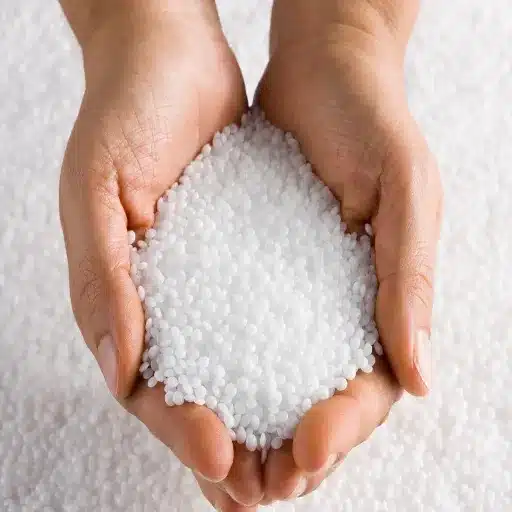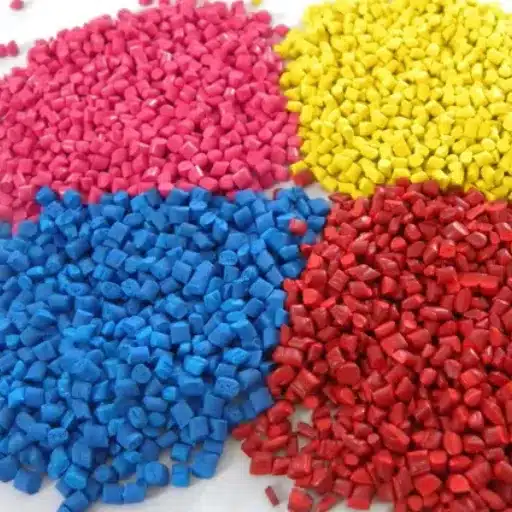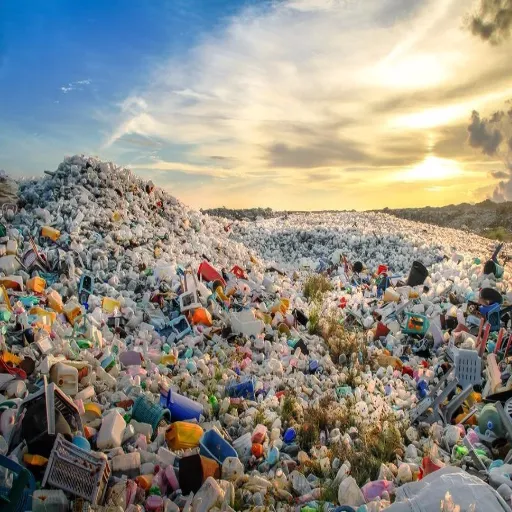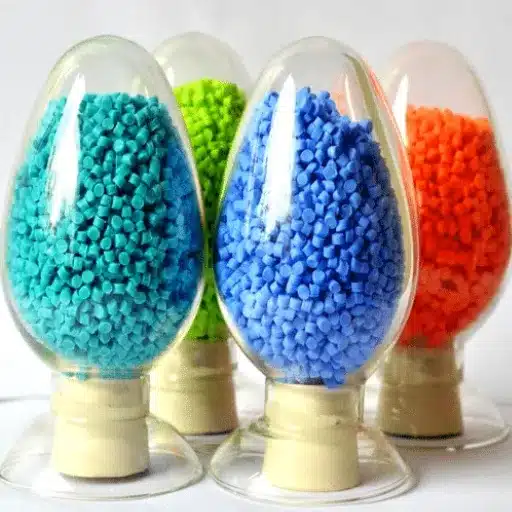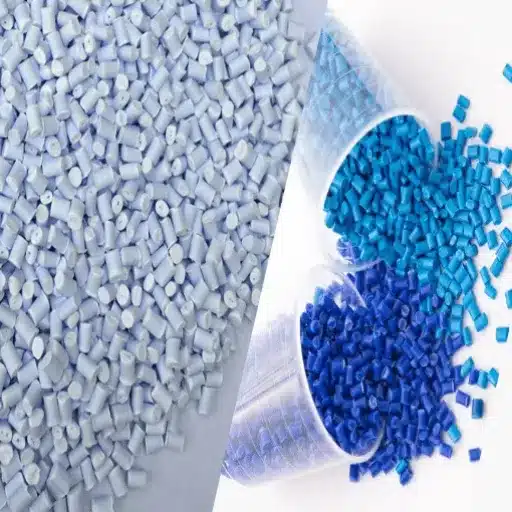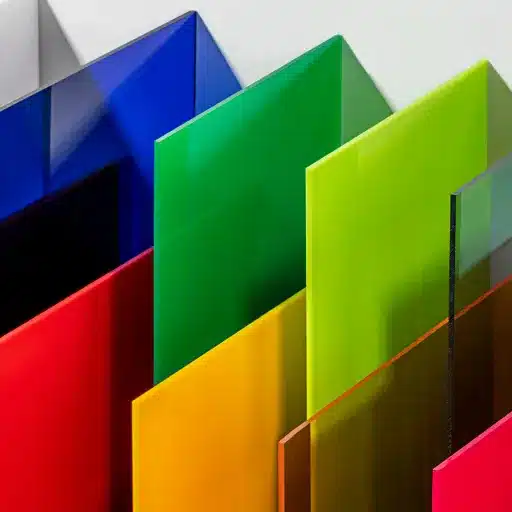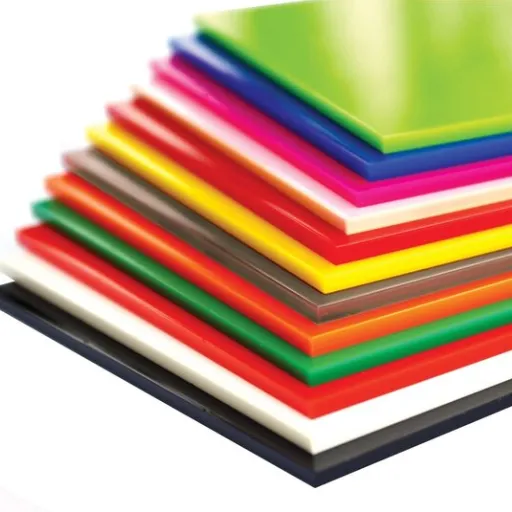Comparing PE and PVC pellets might be hard if distinguishing one from the other is difficult, but it is definitely not impossible to understand. PE and PVC are two ubiquitous polymers used across industries such as construction, consumer goods, and electronics. The difference between them is one of the most significant challenges for beginners in the industry; however, knowing them exactly will make you very competitive in the market. But what really separates PE from PVC??? This article provides a full-fledged comparison of these two materials, covering key properties, advantages, and potential downsides. You will be able to tell which one is perfect for your manufacturing needs by the time you finish reading this blog post, and you can then be a company that considers the environment, the cost and time factor, and the performance of the product.
Understanding Pellets in Industrial Use
Definition of PE and PVC Pellets
PE (Polyethylene) Pellets
PE (Polyethylene) pellets are thermoplastic polymer materials with a wide range of applications. Their outstanding toughness, flexibility, and chemical resistance made them among the most sought-after plastics. The production of packaging films, containers, and piping systems is impossible without these pellets as raw materials. Being lightweight and having no water absorption are the reasons PE pellets are the best choice for applications that require both flexibility and strength.
PVC (Polyvinyl Chloride) Pellets
On the contrary, PVC (Polyvinyl Chloride) pellets are known for their strength and durability. They are the perfect fit for heavy-duty applications. The construction sector is PVC’s primary market, not only for pipes but also for window frames and flooring, due to its resistance to fire and long-term durability. Providing high environmental stress resistance and maintaining the structure of concern, PVC pellets are the first choice for industries that cannot compromise on quality.
PE and PVC granules are available in different grades and are designed for specific purposes in manufacturing. The properties of these materials make them suitable for creating highly specialized products, thereby offering manufacturers a solution that is adaptable and, at the same time, very efficient, with output and quality remaining at acceptable levels.
Applications of PE Pellets
Being versatile, durable, and adaptable, PE pellets are used in most industries for one reason or another. One of the applications that are pretty common with them is packaging, since they are very light and at the same time resistant to moisture, making them ideal for producing plastic films, bags, and containers. This way they would ensure that the goods are safe during transportation and the storage can be made secure, especially in the food and beverage industry, where the transportation of goods without any damage or pollution is a must.
- Packaging Industry: Plastic films, bags, and containers for food and beverage protection
- Plumbing Industry: Pipes, geomembranes, and insulation materials
- Automotive Sector: Fuel tanks, car interior parts, and protective covers
- Consumer Goods: Household items manufactured through injection and blow molding
Polyethylene (PE) pellets are widely used in the plumbing industry for their high strength and resistance to environmental factors. They make up a third of the components in pipes, geomembranes, and insulation materials, which result in the same amazing features. Moreover, PE pellets end up in the automotive sector, where they help manufacture fuel tanks, car interior parts, and protective covers, among other goods, whose resistance to chemicals and mechanical stresses is well-suited.
Furthermore, PE pellets are key materials in the household consumer sector since they are non-toxic and easy to be molded. The use of computerized production methods, such as injection and blow molding, to enhance production efficiency and precision has ensured their place in the highly competitive market.
Applications of PVC Pellets
PVC pellets are very important across a variety of industries due to their high flexibility and excellent performance. PVC pellets are indeed the mainstay of the construction industry for making pipes, window frames, flooring, and roofing materials, as they are weather- and corrosion-resistant. The automotive industry considers PVC pellets a must-have for the production of interior trim, cable insulation, and seals, as they are flame-resistant, flexible, and economical.
- Construction Industry: Pipes, window frames, flooring, and roofing materials
- Automotive Industry: Interior trim, cable insulation, and seals
- Medical Sector: Medical tubing, blood bags, and disposable items
- Packaging Industry: Cling wraps, blister packs, and rigid containers
Another critical area where PVC pellets play a significant role is the medical sector. They are indispensable in the production of medical tubing, blood bags, and disposable items, thanks to their technology, which essentially maintains sterility and meets even the most stringent regulatory standards. Also, the versatility of PVC reaches the packaging world; as a matter of fact, poultry packaging and food packaging users cannot imagine packaging without PVC cling wraps, blister packs, and rigid containers used to pack and protect their goods from the environment.
PVC pellets have become a key material in contemporary production systems, ensuring high performance and meeting the requirements of a wide variety of manufacturing processes, ranging from consumer goods to specialized industrial components.
Comparative Analysis of PE and PVC Pellets
Physical Properties and Characteristics
Physical properties and characteristics of PE and PVC pellets are key determinants of their suitability for specific applications. The fact that the former is lightweight, flexible, and impact-resistant makes PE pellets the perfect option for applications requiring materials that are both long-lasting and malleable, such as packaging films, plastic bags, and piping systems. Besides, the high chemical resistance of PE ensures its continued service life in regions exposed to solvents or corrosive substances.
PVC pellets, on the other hand, have a higher density and can resist prolonged heat exposure well. PVC pellets are also capable of withstanding extreme conditions and are more durable than PE, making them a perfect choice for furniture and the building industry. On top of that, PVC is used in the production of electric cable and plastic bags. PVC has high oil and chemical resistance, making it favorable for the construction sector.
In summary, polyethylene and polyvinyl chloride are equally flexible and offer distinct benefits. The final choice between these two would depend on a specific application that focuses either on the material’s flexibility and impact resistance or on its rigidity and thermal stability. Once the materials’ properties are fully understood, the decision-making process for manufacturers selecting the most suitable material for their production needs will be data-driven.
Cost Implications of PE vs PVC Pellets
The cost discrepancies between polyethylene (PE) and polyvinyl chloride (PVC) beads are primarily determined by factors such as commodity shortages, production processes, market demand, and application specifications. No other than The PE itself: it is the first, with a lower production cost, because it is a compact polymer that can be made almost everywhere. The production of PVC is equally inexpensive. Taking all these factors into account, the material producers focused mainly on high-volume industries that use PE as their raw material. In addition, the high recycling potential of PE and its lower energy consumption in manufacturing are further factors that can justify its cost efficiency in some sectors.
💰 Cost Factors to Consider
- Production Complexity: PVC requires more complex processing with additives
- Raw Material Prices: Subject to market fluctuations and supply chain dynamics
- Recycling Potential: PE has higher recyclability, reducing long-term costs
- Energy Consumption: PE generally requires less energy in manufacturing
- Lifecycle Performance: PVC’s durability can offset higher upfront costs
On the other hand, PVC pellets generally involve more complex production processes, including the addition of stabilizers, plasticizers, and other compounds to achieve desired properties. These additives can increase overall material costs, especially for specialized PVC formulations tailored to specific applications, such as medical-grade or flame-retardant variants. However, PVC’s durability and resistance to environmental factors can make it a cost-effective option for long-term projects and applications that require extended lifecycle performance.
Other factors influencing the cost include supply chain dynamics, fluctuating raw material prices, and regional manufacturing trends. Manufacturers are encouraged to analyze lifecycle costs, application-specific performance needs, and potential material efficiencies when choosing between PE and PVC for their products. By doing so, they can balance upfront costs with long-term value for optimized production strategies.
Durability and Longevity
Durability and longevity are important factors to consider when deciding between polyethylene (PE) and polyvinyl chloride (PVC) for manufacturing. PE, on the one hand, is highly resistant to extreme environmental factors such as temperature differences, UV rays, and chemical impacts, and thus it is suitable for demanding applications such as piping, geomembranes, and outdoor storage solutions. PE is not only flexible but also does not crack under stress, which is a good thing for places where it will be used for a long time.
PE Durability Features
- Resistant to temperature differences
- UV ray protection
- Chemical impact resistance
- Does not crack under stress
- Flexible and long-lasting
PVC Durability Features
- Excellent toughness and rigidity
- Withstands heavy loads
- Superior impact resistance
- Enhanced with stabilizers
- Ideal for construction applications
In contrast, PVC is unarguably good at being tough and rigid, especially in construction and infrastructure applications. The material is ubiquitous for window frames, plumbing, and insulation, and its ability to withstand heavy loads without needing to be replaced over time is a major plus for customers. The strength and impact resistance required in some industries are high. For such needs, PVC, with the latest stabilizers and additives, is unbeaten in the market for durability and efficiently meets the strict standards of these industries.
For optimal material performance, it is crucial to assess, alongside environmental exposure factors, the specific use case. Manufacturers can prioritize durability, cost-efficiency, and sustainability while still using the latest material technologies. These aspects guarantee that the industry and consumer needs are met with the products being long-lasting and efficient.
Environmental Impact of PE and PVC Pellets
Sustainability of PE Pellets
The use of Polyethylene (PE) pellets has received much focus as a driver of more sustainable practices in industrial applications. PE is one of the most prevalent plastic materials and thus among the major contributors to the sustainability of the industry through the emergence of innovations in recycling and reuse. Contemporary techniques of recycling, for instance, chemical recycling, have been a key milestone on the way to creating new materials, and the quality of these materials will remain constant while waste is minimized. Another way to decrease dependence on fossil fuels is to augment them with biodegradable materials from naturally occurring sources or derived from them.
♻️ PE Sustainability Advantages
- High Recyclability: PE can be recovered and reused efficiently
- Chemical Recycling: Advanced techniques maintain material quality
- Lower Toxicity: More environmentally friendly composition
- Circular Economy Integration: Supports continuous reuse cycles
- Reduced Landfill Waste: Contributes to resource conservation
PE pellets have a high likelihood of being recyclable, which strengthens their sustainability factor. In fact, polyethylene has a strong affinity for recycling (or rather, for being recycled), making it possible to recover and reuse quite large amounts of the material. On the other hand, if the product design strategies for this plastic are also simplified to meet the recycling-ease criterion, a further improvement in environmental performance would be realized. Such endeavors align with the circular economy philosophy, ensuring that PE pellets are continually incorporated into production and reuse, reducing landfill waste and conserving resources in ever-increasing amounts.
Environmental Grumblings over PVC Pellets
PVC pellets are highly harmful to the environment due to their composition and ecological impacts. The production of PVC involves chlorine and other chemical additives, some of which can be hazardous to both humans and the environment. Unattended PVC pellets can be a source of microplastic pollution as they abrade and break down into tiny particles that persist in the environment for a long time. In addition, the management and disposal of PVC products are complex; burning can release toxic dioxins, and landfills may allow these chemicals to leach into soil and water systems over time.
⚠️ PVC Environmental Concerns
- Chlorine Production: Hazardous to humans and environment
- Microplastic Pollution: Breaks down into persistent particles
- Toxic Dioxins: Released during burning
- Chemical Leaching: Contaminates soil and water systems
- Difficult Recycling: Complex chemical structure limits recyclability
The recycling process is a major issue. PVC is very different from commonly recycled materials, as its chemical structure is complex and it contains several additives that are difficult to extract. Thus, PVC recycling is very problematic, and the process is costly and energy-intensive. In the end, waste rates are very high. These points together lead us to conclude that it is crucial to limit the use of PVC as long as other materials are available and to be part of the solution through recycling.
Recycling and Disposal Methods
Reusing and disposing of PVC require professional techniques due to its chlorine content and the chemicals used in manufacturing. One of the main methods, mechanical recycling, is widely used: PVC is classified, washed, shredded, and then converted into new items. Nonetheless, this method can lead to a loss of the matter’s quality over time. The development of chemical recycling has created potential alternatives through PVC disintegration, yielding recovered materials of higher purity and quality. There is a prospect for the ultimate resolution of the PVC waste issue through pyrolysis and hydrothermal techniques, which have already been recognized as effective forms.
Incineration is often used for disposal, yet it requires strict control of the release of harmful dioxins and other pollutants. Through landfilling, toxic additives leach into the soil and groundwater; however, it is impossible to eliminate environmental concerns. To overcome these issues, companies are increasingly promoting the idea of a circular economy as well as the extended producer responsibility (EPR) programs. They stipulate that manufacturers also consider the cradle-to-grave material management. Sustainable practices and inventive strategies will always be necessary for progress throughout the lifecycle of PVC and for reducing its environmental impact.
| Recycling Method | Description | Advantages/Disadvantages |
|---|---|---|
| Mechanical Recycling | PVC is classified, washed, shredded, and converted into new items | Can lead to quality loss over time |
| Chemical Recycling | PVC disintegration yielding higher purity materials | Better quality recovered materials |
| Pyrolysis | Thermal decomposition process | Recognized as effective form |
| Hydrothermal Techniques | Water-based recycling process | Promising for waste resolution |
| Incineration | Controlled burning for disposal | Requires strict control of dioxin release |
| Landfilling | Traditional waste disposal | Risk of chemical leaching to soil/groundwater |
Industry-Specific Applications and Preferences
The Significance of Pellets in Beanie Babies Production
Employing pellets in the manufacturing of Beanie Babies has been a game-changer, setting the beloved toys apart while superficially and functionally conditioning them and making them easier to handle. What would be known as ‘bean bag fill’, they have been chosen for both their weight, which gives a natural feel, and the sharp outline visible through the stuffing. As a result, the use of pellets has offered baby internet-sensation-simple characteristics and at the same time, has made them user-friendly and posable.
🧸 Key Benefits of Pellets in Beanie Babies
- Uniformity: Consistent quality across all products
- Long-lasting Nature: Durable for extended use
- Freedom from Harmful Substances: Safe for consumers
- Reasonable Cost: Maintains affordability
- Poseability: Allows for flexible positioning
These pellets are highly valued for their uniformity, long-lasting nature, freedom from harmful substances, and reasonable cost. The consumers get the best quality of Beanie Babies as a result and, at the same time, the company preserves its reputation.
The polymer technology sector’s innovative changes have had a significant impact. The new pellets, with a lower environmental impact, are more abundant and made from recycled plastics or biodegradable materials. So, by using these eco-friendly options the manufacturers are providing a solution to the condition of the environment and at the same time maintaining the touch and the structure essential to the Beanie Babies’ design. The change is quite in line with the toy industry’s support of the planet; it has been, without doubt, very much so even without affecting the quality of the product.
Also, the adoption of new machinery has helped solve the problem of not being able to fill the toy consistently, which is now easily achieved with the help of technology. Thus, companies adopting these new technologies can easily scale up production without creating as much unnecessary waste. And the care of the pellet usage remains a crucial factor in the already well-rooted, still-growing interest in Beanie Babies and their collectability, in a harmonious combination of form, function, and green policy.
Textile and Upholstery Applications
The introduction of pellets and other similar materials in textile and upholstery applications has been a significant game-changer on the sector as it has come up with new solutions to comfort, strength, and personalization. The use of high-quality pellets in cushioning, bean bags, and ergonomic furniture is widespread to provide users with a dynamic, supportive structure that conforms to the body’s shape. This strategy not only improves the user’s comfort but also extends the product’s lifespan by permanently maintaining its shape. Moreover, manufacturing companies can now produce light, cost-effective, and high-quality products with the help of advanced materials. Those developments have been beautiful to the consumers who are demanding sustainable and versatile home furniture all in one thus increasingly showing the blend of technology and textile innovation in our daily lives.
Packaging Industry Preferences
There has been a remarkable change in the packaging industry in terms of design and materials, which reflects the growing consumer consciousness and the laws regulating environmental impacts as well. Materials like biodegradable plastics, recycled paperboard, and compostable films are now an eco-friendly priority for companies, alongside the quest for the ecological umbrella. They want the products to be still durable and safe thus their choice of materials is brilliant. Additionally, convenience and beauty are the criteria packing and other businesses consider in the same way as the user experience when using the products. They are even more explicit in their choice of resealable packaging, user-friendliness, and brand appeal. In the end, the current trend in the industry is a natural reflection of its environmental responsibilities that do not forsake the consumer’s loyalty and the excellent quality of the goods manufactured and the user-friendliness of the packages.
Consumer Insights and Market Trends
Trends in the Use of PE vs PVC Pellets
The demand for polyethylene (PE) and polyvinyl chloride (PVC) pellets has been highly variable and continues to be the major factor in their use, driven by market demand, land-use changes, changes in environmental laws, and technological progress. The transition of polyethylene to an ever more popular material brings us closer to the benefits of recyclability and versatility. Its users primarily come from such industries which are eco-conscious or that support sustainable production and hence the material is also recycled.
📈 PE Market Growth Drivers
- Increased recyclability focus
- Versatility in applications
- Eco-conscious industry adoption
- Circular economy integration
- Renewable energy project compatibility
🏗️ PVC Market Strengths
- Construction sector dominance
- Cost-effectiveness
- Infrastructure versatility
- Lifecycle assessment improvements
- Innovation in production methods
Nevertheless, PVC is still widely used in the construction and infrastructure sectors because of its strength, cost-effectiveness and versatility. On the other hand, critics worry about its eco-friendliness and the presence of plasticizers, but such concerns have not yet significantly shifted the market. It is a shift concealed in the seamless blending of sustainability and industrial requirements. Where it was once the only option or the best option, it is now sharing the victory podium, and, professional bodies and engineering firms find it difficult to break loose.
Three main factors influence pellet selection: cost-performance ratio, recyclability, and compatibility with green certifications. The preference of PE is, however, increasing because of its perfectness for use in renewable energy projects and the channeling of its integration into the circular economy promotions. As for PVC, its drawback notwithstanding, it is taking the benefit of the innovation and all the stress now placed on lifecycle assessments to reduce the environmental effect. The two materials are very much in step with the trends and are not just the customers looking for a good product but also the environment-conscious customers—they serve them both at the same time. Convergence around the need for durable, environmentally friendly materials is a sign of industry-wide emphasis on finding the right balance between performance and eco-care.
Consumer Preferences and Perceptions
As per my observation, the relationship between buyers’ likes and dislikes of PVC and composite materials has been moving increasingly toward sustainability and the environment. That is, current consumers are not only concerned with performance figures but also want to know the durability of the materials they are going to purchase. It can be said that a good number of customers are opting for products that are environmentally friendly, and therefore, the different angles of renewable and closed-loop modes of production have been explored. That is why composite materials, which are typically recyclable and the first choice for the green movement, are making their way into the industrial and residential markets alike.
🌍 Shifting Consumer Priorities
- Sustainability First: Environmental impact is a primary concern
- Transparency Demand: Full production and distribution visibility required
- Certification Importance: Environmental declarations and certificates expected
- Long-term Value: Investment perspective over short-term savings
- Eco-friendly Innovation: Support for advanced green technologies
Moreover, the viewpoint on PVC has been changing slowly as well. Though conventional concerns about its environmental impact remain, production is advancing and becoming greener through advanced techniques such as bio-based additives and highly efficient recycling methods. Customers are slowly realizing that manufacturers are actively addressing these issues and that their use of PVC can contribute to sustainability, especially when innovations are implemented. Nonetheless, all the processes involved in the production and distribution of materials through to the end products must be publicly available and traceable since customers having an effect on the environment through their purchase are to be well informed and thus will be requesting environmental declarations and certificates.
In the long run, the increasing focus on sustainable development means materials must find a balance between functionality and responsibility. The trend is moving towards the use of products that are good investments from a long-term perspective and that are not against ecological trends. This double requirement makes it really really hard for manufacturers to just keep up with the market let alone be ahead of it. Thus, they are forced to develop new solutions and adapt their businesses to new demands if they are to survive, let alone thrive. Either way, one thing is clear: the market is increasingly defined by consumers who prefer environmentally friendly products.
Future of Pellets in Industrial Applications
I see the future of pellets in industrial applications as very bright and promising, driven by technological advances and the growing demand for eco-friendly, efficient manufacturing solutions. Whether the pellets are made from wood, plastic, or bio-based materials, they are essential in energy production, manufacturing, and agriculture. Their versatility is one of the key points; that is to say, pellets can very easily be made precisely for specific industrial process needs and that goes from being a feedstock for biorefineries, and giving a renewable option to the fossil fuel use, for instance, in the heating and energy generation process….
🔮 Future Industry Developments
- Advanced Materials: Recycled content and bio-based materials integration
- Energy Efficiency: Lower production energy consumption
- Better Combustion: Improved performance characteristics
- Carbon Footprint Reduction: Environmental impact minimization
- Cost Optimization: Enhanced market competitiveness
Moreover, the industrial use of sustainable pellets has greatly benefited from advances in materials production and related technologies. As an example, the use of recycled content and bio-based materials have substantially matched the goals and objectives of the world sustainable pellet production. Companies that are delving into creating and perfecting pellet technology are those who are investing in R&D. They are aiming at bringing those pellets to the market that are longer lasting, consume less energy in production, and make a better combustion which, in turn, not only lessens the carbon footprint but brings in cost reductions as well, thus giving an edge to pellets in a very competitive market.
I predict a rise in the use of pellets across factories in the future, owing to the shift companies may need to make toward greener practices to comply with increasingly stringent environmental laws. According to the latest factory equipment technology and efficient supply chain management, the pellets will no doubt be a significant, almost irreplaceable link in the chain. Since the new trends point to a large use, production and application of the pellets, in a way, it seems that the pellet-based industries will be the ones to lead the rest in future toward a sustainable and efficient way of operation.
📚 Reference Sources
Frequently Asked Questions (FAQs)
❓ How Do PE Pellets Differ from PVC Pellets?
PE pellets and PVC pellets are two main types of plastics with slightly different compositions and uses. The first one, PE, or polyethylene, is flexible and is frequently used in packaging and containers. To the contrary, PVC, or polyvinyl chloride, exhibits strong, tough properties and is typically used in construction and plumbing. Among the several criteria to be considered in comparing PVC vs PE pellets are their ‘points at which they start to melt’, their ‘fighting-back’ abilities, and their ‘throwing the environment into a bad state’. PE pellets are widely considered the most environmentally friendly choice; one of the main advantages of PVC pellets is their stiffness. At the end of the day, the selection of the appropriate pellet type will primarily depend on the project’s specific needs.
🧸 Are Beanie Babies Made From PE or PVC Pellets?
Classic Beanie Babies have different kinds of fillers inside them. Some use PE pellets because they are soft and flexible, which makes the soft toy cuddlier. On the other hand, PVC pellets are sometimes used in the Beanie Babies to give them more weight and toughness. The decision to use PE or PVC can affect a toy’s comfort and lifespan. PE-filled Beanie Babies will likely be more eco-friendly, while PVC-filled ones might last longer. People are advised to always go for the tag and check what is specified in the stuffing when collecting or buying.
🔍 How Do I Discover the Types of Stuffing Used in Beanie Babies?
One way to distinguish the stuffing in Beanie Babies is to check the tag, which provides information about the materials. Sometimes tags also tell you whether the Beanie Baby is filled with PE or PVC pellets. “Polyethylene” on the tag indicates that the toy is filled with PE pellets. On the other hand, if the tag says “polyvinyl chloride,” the Beanie Baby is most probably filled with PVC. Also, the feel of the Beanie Baby can give hints: those that are softer are more likely to have PE, and those that are firmer might be PVC or other materials. Collectors can more accurately value and authenticate Beanie Babies by simply knowing the type of pellets.
🌱 What are the Environmental Impacts of PVC vs PE Pellets?
The usage of PVC and PE pellets get highly influenced by their environmental pursuits. It is a generally accepted fact that PE pellets are the more environmentally friendly option due to their recyclability and lower toxicity. However, PVC pellets are not considered the same option, as they can emit harmful chemicals both during production and later when they are discarded, causing environmental problems. The matter of PVC vs PE is fundamental to talk about it when it comes to different industries that would like to improve their ecology and going eco-friendly. Many producers are now very much occupied with other options and creative methods to reduce the harm from PVC. The type of pellets used may well reflect the company’s level of effort to pursue sustainability.
⚙️ How do PVC Pellets Compare to PE Pellets Regarding the Production Process?
There are several differences between the manufacturing processes of PVC and PE pellets. PVC pellets undergo polymerization of vinyl chloride, a highly toxic material that must be handled with care. In comparison, PE pellets are obtained by polymerizing of ethylene which is often a safer and simpler method. Pellets are the primary product suitable for specific applications—for example, PVC for construction and PE for consumer goods. The dynamics behind the processes will help identify the material more appropriate for particular uses.
🔄 Would you ever want to try using PVC pellets in the same applications as PE pellets?
Although there may be some similarities, it is not preferred to use PVC compounds for the same purpose as PE. The reason is that PVC pellets are harder than PE pellets and are primarily used in construction and plumbing. In contrast, PE pellets, because of their flexibility, are perceived as the frontrunners for the packaging and toys sectors. The beanies stuffed with PVC pellets, for example, will feel rougher than the soft ones consumers like. Furthermore, in some instances, the environmental effects of PVC use can lead to a drop in consumption, as before. It is therefore obligatory to carefully consider the requirements of each application before deciding on the use of PVC or PE pellets.

